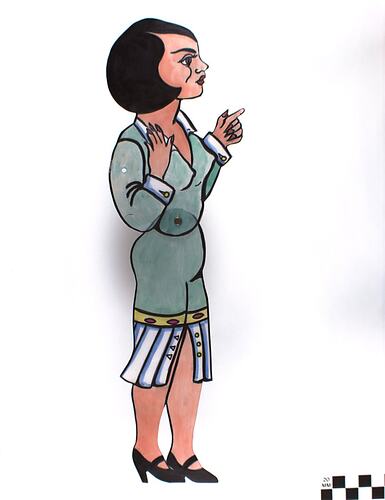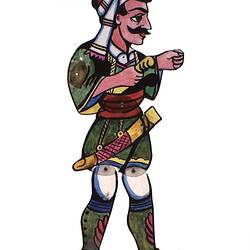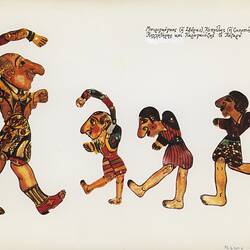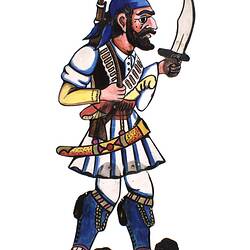Summary
This puppet was made in the 1960s by the Greek puppeteer and popular artist Abraam (Antonakos) in his Athens workshop, and used in performances in Greece during the 1960s. This and most of the puppets in the collection were brought to Australia by Abraam Antonakas for his performances at the Astor Theatre in Melbourne in 1977. He then left the collection with Dimitri Katsoulis who used them in all his subsequent performances in Victoria and in South Australia from 1978 to 1991. Dimitri Katsoulis migrated to Australia in 1974 to escape a regime that repressed Greek artists. He had trained in Greece with theatre and film companies as an actor and technician. A master of the traditional Greek shadow puppet theatre, his performances explored contemporary issues such as the isolation of migrant women and children. Unable to obtain funding and support, he returned to Greece in 1991, leaving his entire collection to the people of Victoria. It includes 32 shadow puppets and around 170 props, set backdrops and technical tools and stage equipment. Dimitri has since returned to Melbourne and assists the Museum to continue to document this rich art form within both local and international contexts.
Eleni is a character in the centuries-old Greek Shadow Puppet Theatre (Karaghiozis) tradition. She is a secondary key character, obedient, well mannered due to being educated, and always in love. she appears in 2-3 comedies. In the comedy 'The Engagement of Uncle Yiorgos', Uncle Yiorgos goes to the house to ask for her hand in marriage, but due to Yiorgos' loud yelling, Stavridis is frightened and doesn't open the door. He gives his servant, Karaghiozis, extra money to intervene. Karaghiozis calms Eleni who is crying from fear and goes outside. He calms down Yiorgos and tells him that the girl will come outside; however, he explains that as she is shy, he will need to keep his head bowed down and she will express her love with blows to his head. Karaghiozis then goes back inside. He comes out again and in a woman's voice he asks Yiorgos if he loves Eleni. He says yes. Karaghiozis sighs and gives him the first blow to the head. This is repeated a few times, until suddenly the Yiorgos raises his head and sees that it is not the girl but Karaghiozis that has been hitting him. He pounces on him and chases him off the stage.
The puppet is manipulated by a puppet rod [there are many examples in the collection] mounted at the top of its shoulder.
Information supplied by Greek Shadow Puppet Theatre master Dimitri Katsoulis, 2007.
Physical Description
A two-dimensional acrylic figure, jointed at the waist, portraying a woman. She has short black hair and wears a green, long-sleeved, close-fitting dress with white trim at collar, cuffs and hem.
Significance
This collection of puppets, props, stage sets, and technical tools and equipment relating to traditional Greek Shadow Puppet Theatre is unique in Australia and rare in international public collections. The history of Greek Shadow Puppet Theatre, its puppet characters and the methodology of its performance has been recorded in partnership with the puppet master to whom the collection belonged. The collection is highly significant both as documentation of an important cross-cultural, centuries-old art form, and as an example of the transnational migration of cultural activity between Greece and Australia. It is a collection which was created and performed in Greece and Australia from the mid to late twentieth century, by two puppet masters, who transported the tradition between two countries. Abraam Antonakos came to Australia in 1977 to perform the puppet theatre and then deposited the puppets with Dimitri Katsoulis, who had migrated to Australia in 1974. Dimitri's story becomes one of migration experience, cultural maintenance and adaptation, and finally return migration and the discontinuance of this cultural art form in Australia.
More Information
-
Collection Names
-
Collecting Areas
-
Acquisition Information
Purchase
-
Artist
-
User
Mr Abraam Antonakos, Athens, Greece, 1960-1977
Abraam made the puppet in Greece, and used it in performances during the 1960s and 1970s; and then in Victoria in 1977. -
User
Mr Abraam Antonakos, Victoria, Australia, 1977
Abraam made the puppet in Greece, and used it in performances during the 1960s and 1970s; and then in Victoria in 1977. -
User
Mr Dimitri Katsoulis, Australia, 1978-1991
Dimitri was given the puppet by Abraam in 1977 and then used it in his performances in Australia until 1991. -
Medium
Ink
-
Support
Plastic
-
Classification
-
Category
-
Discipline
-
Type of item
-
Overall Dimensions
23 cm (Length), 71 cm (Height)
-
References
[Link 1] Malkin, Michael, R. Traditional and Folk Puppets of the World, A.S. Barnes & Co., Inc., N.J., 1977; Simmen, Rene, The World of Puppets, Elsevier, Phaidon, London, 1975; Hogarth, Ann & Bussell, Jan, Fanfare for Puppets!, David & Charles Publishers Ltd, USA, 1985; Yayannos, A & Ar and Dingli, J. The World of Karaghiozis, 1976
-
Keywords
Cultural Maintenance, Greek Communities, Greek Immigration, Karaghiozis Theatre, Shadow Puppetry, Theatres, Working Life



